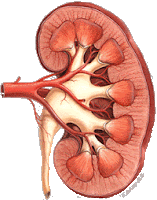Sunday, September 30, 2012
93,413
That’s the number, as of September 19th, of Americans waiting desperately for a kidney transplant. “Last year, 4,720 people died while waiting for kidney transplants in the United States. And yet, as in each of the last five years, more than 2,600 kidneys were recovered from deceased donors and then discarded without being transplanted, government data show.” New York Times, September 19th. Huh? OK, some of them just turned out to be unsuitable for one reason or another, but estimates say that around half were indeed viable for a match. It’s an old system, established by the federal government a quarter century ago, based on a first come, first serve priority registry administered through an outsource contract with the non-profit, United Network for Organ Sharing (UNOS). The system doesn’t work well in a modern era and is badly (duh!) in need of updating.
“The current process is made inefficient, they say, by an outdated computer matching program, stifling government oversight, the overreliance by doctors on inconclusive tests and even federal laws against age discrimination. The result is a system of medical rationing that arguably gives all candidates a fair shot at a transplant but that may not save as many lives as it could… ‘There is no doubt that organs that can help somebody and have a survival benefit are being discarded every day,’ said Dr. Dorry Segev, a transplant surgeon at Johns Hopkins University School of Medicine… One recent computer simulation, by researchers with the Scientific Registry of Transplant Recipients, projected that a redesigned system could add 10,000 years of life from just one year of transplants.
“Currently, the country is divided into 58 donation districts. When a deceased donor kidney becomes available, the transplant network’s rules dictate that it is first offered to the compatible candidate within the district who has waited the longest. Additional priority is given to children, to candidates whose blood chemistry makes them particularly difficult to match and to those who are particularly well matched to the donor. If no taker is found locally, the electronic search expands to the region and eventually goes national… The kidney matching system does not, however, consider the projected life expectancy of the recipient or the urgency of the transplant. By contrast, the systems for allocating livers, hearts and lungs have been revised to weigh those factors.
“As a result, kidneys that might function for decades can be routed to elderly patients with only a few years to live. And when older, lower-quality kidneys become available, candidates atop the list and their doctors can simply turn them down and wait for better organs. If that happens too often, doctors say, a kidney can develop a self-fulfilling reputation as an unwanted organ.” NY Times. Kidneys have a very short survivability period after being recovered. They really need to be transplanted within 24 to 36 hours. Frustrations with kidneys that failed after transplant and patients who turn down the “what’s next” organ generate doctor resistance to the process that adds a layer of waste to the process.
A special committee established by the UNOS eight years ago to redesign the system is still struggling with age discrimination laws, intense federal oversight and a general resistance to change. Some European systems, such as the organ matching that is used in Germany, will pair donors in older age categories with recipients in the same category… simple but effective. “The number of older kidney donors has more than tripled, and discard rates are less than a third of that in the United States, said Dr. Ulrich Frei, a German nephrologist who has compared the two systems. Studies have found no significant difference in survival rates for older patients in Europe and the United States, he said… Dr. Frei said he found the discard rate in the United States ‘quite disturbing.’ The reliance on biopsy is misplaced, he said, and valuable hours are wasted in the sequential search for a taker for a lower-quality kidney. That they wind up discarded, he said, is ‘a self-fulfilling prophecy.’” NY Times.
UNOS is offering a new plan that is at best a marginal improvement of what went before: “As with the prior plan, the top 20 percent of kidneys would be matched to the candidates expected to survive the longest, placing older patients at a disadvantage. But the remaining 80 percent would still be allocated primarily by time spent on the wait list.” NY Times. The vote probably won’t come till June, but the fact that there are so many better systems out there, that our computer analytics can handle a more efficient and certainly more rapid matching and implementation system and that there are specific proposals with such better systems proposed by experts in the field… that are being ignored… is beyond disturbing.
The mythology that the United States has the best medical care in the world fails on so many levels, and this is one more example. We need to stop lying to each other about what we have. We have a system that costs the most per capita on earth, still leaves significant numbers of people without access to healthcare (even if they can afford a policy), has the fastest rate of cost increases in the world, protects incumbent industries (like the pharmaceutical companies) from competition and clearly favors those able to pay for the most expensive policies or special upscale hospital care even over those with seemingly solid health insurance. For those with the ability to pay for it, perhaps they have access to the best healthcare system on earth… and can travel to Europe and pay for specialized care when the FDA is still struggling to approve an advanced treatment option.
I’m Peter Dekom, and exactly when are Americans going to fall back in love with facts over slogans?
Subscribe to:
Post Comments (Atom)






No comments:
Post a Comment